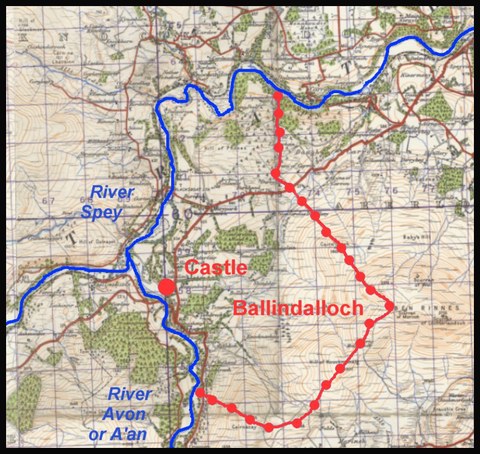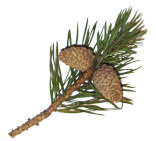Ballindalloch today is an imposing castle and vibrant business whose châtelaine, Clare Macpherson Grant (Mrs Clare Russell) served as (the first Lady) Lord Lieutenant of Banffshire from 2002 to 2019. The reason for including a page about the Grants of Ballindalloch is principally because it has been a significant base for Grant power for a very long time and, despite this, has been rather ill-served by Grant histories; Sir William Fraser in particular engaged in considerable “air-brushing”.
Original lands of Ballindalloch
Likely approximate extent of the original estate

Base map: maps.nls.uk
Beginning of Grant interest
The Lands of Ballindalloch came to the Grants when Sir Duncan Grant acquired a Crown Tack of the land – in other words he rented it from the king. Fraser tells us that this was the situation in 1457 – and this may represent the date of entry. The list of the Earls of Moray that the earldom fell vacant in 1454 with the death of James Crichton and there was no new appointment until 1499. So in the meantime the earldom will have reverted to the Crown, which is why King James II (of Scotland) would have been in a position to rent the land out to a loyal and trusted supporter.
The Progenitor of the 1st House of Ballindalloch
Sir Duncan Grant was born in the period 1410x15. The MS histories tell us that he and his wife, Muriel Macintosh waited quite some time before their first children were born – and they turned out to be twins, John and Patrick.
A tale is told about this in all the MS histories: when Muriel went into labour the first thing to emerge was a hand – and the attendants tied a ribbon to the wrist. The hand then withdrew and it was the other twin who was born first. Sir Duncan decided that the emergence of the hand would not count for the purposes of primogeniture so it was John who became his heir while the ribbon had been attached to Patrick. The MSS also tell us that Sir Duncan determined that Patrick would be given Ballindalloch. We can see that the numbers to add up – so the tale is at least chronologically feasible.
The reason for Fraser’s airbrushing
Like his father, John Grant, younger of Grant was married to a Muriel Macintosh (his own first cousin). He died in 1482, three years before his father. By this time Sir Duncan was really not fit enough to be the chief he needed to be and John’s son (also John who would become the ‘Bard Roy’) was still a minor. So Patrick became not only the effective Clan Chief but also his nephew’s ‘tutor’ (legal guardian with what we might today call “power of attorney”). He rather liked it and nursed something of a grievance in that it could so easily have been he who was the heir to his father. Meanwhile The Bard Roy was sent to his maternal grandfather for his education and preparation for adult life.
So Patrick of Ballindalloch had been acting as chief, continuing in that vein after Sir Duncan’s death and was reluctant to give it up when his nephew came of age – so much so that there was a stand-off and Macintosh had to appear in Strathspey meaning business to force Patrick to withdraw back to Ballindalloch.
Dates and the missing generation
The result of Fraser’s desire to cover up this “unfortunate incident” is that his pedigree for the family omits the first two generations. It is his grandson (not unnaturally also Patrick) who heads Fraser’s pedigree. However Fraser cannot help himself for, quite properly, he reproduces a charter dated June 1491 (vol III page 39, Item 46) which refers to “Jacobo Grant in Balnadalocht”.
What this tells us is that Patrick’s son was called James, that he was at least 21 in 1491 and that his father had already died – it looks as if the failed coup crushed him.
So James was born no later than 1470 and this suggests that Patrick was born no later than 1449 and both of these dates are very tight. This suggests that Duncan was married by 1435 and the “many” years he had to wait for a child was more likely to be about 5. So John Grant, younger of Freuchie and Patrick, progenitor of Ballindalloch were probably born c1440, making James born in the early 1460s and so in his later 20s in 1491.
A brief survey of the family
“What happened next” is to be seen particularly in the mini-bios on Fraser’s family tree. And there is a useful discussion in the Birkenburn MS. We may note younger sons establishing themselves on neighbouring farms/estates whether particularly by securing charters from the Church.
It is clear that the main Ballindalloch family was in financial trouble – but again Fraser’s airbrushing avoids the detail, so we may speculate about (a) aspiration to a lifestyle beyond their means, (b) being fined for “resetting” MacGregors, (c) resisting the move to protestant Presbyterianism or, perhaps (d) unwise investment eg in the Darien scheme. Eventually John Roy Grant (d. 1737 or earlier) was made bankrupt and the estate was bought “out of administration” by the founder of the 2nd House.
In passing we may note that there was a strong connection to Episcopalianism including one cadet line (from a William) leading to Ludovick Grant the Cherokee trader (see separate page on this site) and another William getting into the same difficulty at the same time as Ludovick.
The line of this family ended with Peter Grant who took the additional surname Leslie when he inherited Balquhain from his maternal grandfather Count Patrick Leslie; but this line died out very quickly.
The 2nd House of Ballindalloch
The Ballindalloch estate was bought out by Colonel William Grant, a younger son of Grant of Rothiemurchus. It is to be noted that his second son was General James Grant who was governor of Florida and who had commanded the forces who had attacked and killed so many Cherokees (who had sided, under some duress, with the French), though it is reported that he did so with great regret.
Such was the military prowess of the male chieftains of this line that there can be no doubt that the estate would have been fully endowed and so would have thrived had there been a male line to hand the estate on to. But…
After him the estate passed though the line of his sister Grace who had married John Macpherson of Invereshie and when her grandson George obtained a baronetcy he styled himself Macpherson-Grant of Ballindalloch and Invereshie.
In his 1983 book, Sir Patrick Grant, the then chief, described this family as “not descended directly from the chief”. Strictly this is not at all true – Colonel Willam was a brother of Patrick “Macalpine” Grant of Rothiemurchus and so descended from Patrick the second son of John Grant 4th of Freuchie. What Sir Patrick really meant was that he was a cadet of a cadet.
Thus the common ancestor of the two houses is Sir Duncan Grant back in the 1400s.
